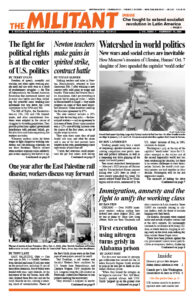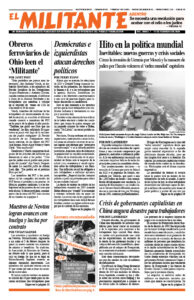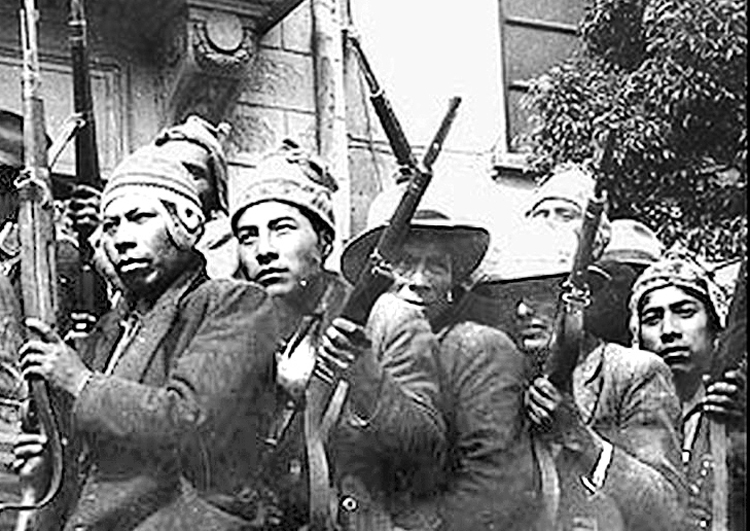The Bolivian Diary of Ernesto Che Guevara is one of Pathfinder’s Books of the Month for February. Guevara, an Argentinian who helped lead the Cuban Revolution, set out in Bolivia to forge a continent-wide revolutionary movement of workers and peasants. The introduction by editor Mary-Alice Waters explains how Fidel Castro led Cuba’s workers and peasants to defend their socialist revolution against Washington’s attacks and aid revolutionaries seeking to follow their example worldwide. Copyright © 1994 by Pathfinder Press. Reprinted by permission.
As Fidel Castro pointed out in his 1960 address to the United Nations General Assembly, the economic, social, and political conditions that made possible the first socialist country in the Americas were not unique to Cuba. The Cuban revolution was only the crest of the rising tide of mass struggles across the continent, which, in turn, registered a new level of energy and explosiveness in the wake of the Cuban victory.
Fear that the example of Cuba would spread and that other proimperialist regimes would be overthrown by mass revolutionary struggle underlay Washington’s determination to crush the workers and farmers government in Cuba. At Wall Street’s bidding, bourgeois governments throughout the hemisphere rushed to try to isolate the revolutionary regime.
The counterrevolutionary war drive orchestrated by the U.S. government included everything from the CIA-sponsored invasion of Cuba in April 1961 (the “Bay of Pigs” landing, which was wiped out in less than seventy-two hours), to the orchestrated expulsion of Cuba from the Organization of American States in January 1962, to the imposition of a brutal embargo on trade with Cuba by the United States a few days later.
On February 4, 1962, at a mass rally of more than a million in Havana’s Plaza of the Revolution, Fidel Castro read the response of the Cuban people, known as the Second Declaration of Havana.
What is it that is hidden behind the Yankees’ hatred of the Cuban revolution? What is it that rationally explains the conspiracy — uniting for the same aggressive purpose the richest and most powerful imperialist power in the contemporary world and the oligarchies of an entire continent, which together are supposed to represent a population of 350 million human beings — against a small country of only seven million inhabitants, economically underdeveloped, without financial or military means to threaten the security or economy of any other country?
What unites them and stirs them up is fear. What explains it is fear. Not fear of the Cuban revolution but fear of the Latin American revolution. … Fear that the plundered people of the continent will seize the arms from their oppressors and, like Cuba, declare themselves free people of the Americas.
Disavowing decades of subordination by the official Communist and Socialist parties of the continent to various bourgeois political parties and currents, the Second Declaration of Havana boldly proclaimed the necessary proletarian leadership and socialist character of the revolution on the agenda throughout the region:
In the actual historic conditions of Latin America, the national bourgeoisie cannot lead the antifeudal and anti-imperialist struggle. Experience shows that in our nations that class, even when its interests are in contradiction to those of Yankee imperialism, has been incapable of confronting it, for the national bourgeoisie is paralyzed by fear of social revolution and frightened by the cry of the exploited masses. …
Young rebels from across the Americas made their way to Cuba to see the revolution with their own eyes. They hoped to learn from its successes and return home to emulate the “Cuban road.” Frequently, in their inexperience and determination, they saw or understood only a one-sided piece of that reality. They saw in bold relief the audacious military victories registered by the guerrillas of the Rebel Army. They often missed the years of party-building work that preceded the landing of the Granma; the stature of the July 26 Movement and the mass support it had won even before beginning the struggle in the Sierra Maestra; the caliber of the leadership team carefully put together by Fidel Castro; the profound roots the movement had among the Cuban toilers and the political astuteness the leadership demonstrated in its feel for the tactical ups and downs of the struggle — in short, the factors that registered almost a decade of work forging and tempering a revolutionary movement that drew on the lessons of a century of struggle, and thus the factors that made possible the victory of the Cuban revolution.
During the first years after the triumph in Cuba, nuclei of guerrilla fighters went into action in the countryside of Venezuela, Colombia, Peru, Guatemala, Nicaragua, Argentina, and elsewhere. Coming from many different political origins, they adopted the banner of the Second Declaration of Havana as their own, challenging the long-established Communist and Socialist parties for leadership of the workers and peasants struggles. Although the majority of these efforts were soon defeated, in a number of countries they had significant and growing political impact.
In hopes of stemming the rising revolutionary tide, the U.S. administration of John Kennedy proclaimed the Alliance for Progress with complicit regimes throughout the hemisphere. …
More importantly, Kennedy responded to the growing popular struggles throughout Latin America by supporting murderous dictatorships; expanding operations by the Central Intelligence Agency, army special forces units, and others; and employing direct military action. …
Che [Guevara] thought and acted as an internationalist. He knew that the future of the Cuban revolution did not ultimately depend on the efforts and capacities of the communist leadership in Cuba of which he was part, however deep-going that revolution might be, however capable the leadership. Only new revolutionary victories elsewhere, especially new socialist advances in the Americas, would change the relationship of class forces internationally and break the isolation that weighed so heavily on Cuba.


